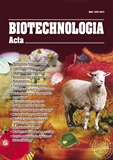ISSN 2410-7751 (Print)
ISSN 2410-776X (Online)

Biotechnologia Acta Т. 16, No. 2 , 2023
P. 32-34, Bibliography 8, Engl.
UDC: 57.577
DOI: https://10.15407/biotech16.02.032
Full text: (PDF, in English)
STRUCTURAL PATTERNS OF IVERMECTIN ALLOSTERIC INTERACTION WITH GLUTAMATE-GATED CHLORIDE CHANNEL OF Caenorhabditis elegans
Y.O. KUSTOVSKIY1,2, A.I. YEMETS1,2
1Institute of Food Biotechnology and Genomics of the National Academy of Sciences of Ukraine, Kyiv
2National University of Kyiv Mohyla Academy, Ukraine
The aim of this research was to determine the structural patterns of IVM allosteric interaction with residues of its binding site located in the transmembrane domain of α-homopentameric glutamate-gated chloride channel (GluClα) of Caenorhabditis elegans.
Methods. To consider different conformational states of IVM binding site two complexes of IVM bound to C. elegans GluClα (each with five site conformations) with identifiers 3RHW and 3RIF were obtained from PDB. The structures were examined in Analyzer Mode of SeeSAR v.12.1.0, in which contributions of IVM atoms into the complex affinity and their interactions with site structural patterns were determined for each site conformation using the HYDE scoring function. The residues belonging to identified structural patterns were classified by their properties using the Taylor’s classification of amino acids.
Results. According to the results, the benzofuran group is critical for IVM recognition and binding: it interacts with the T-A-S-N-D-I-L-Q-I-P pattern, which is formed by T257, A258, S260, and N264 of M2, D277 and I280 of M3 of (+) subunit and L218, Q219, I222, P223 of M1 of (–) subunit. Due to the size and hydrophobicity of macrocycle, its different parts interact with residues of all site-forming structural elements mentioned above resulting in the V-I-G-A-M and I-V-D-L patterns. While the V-I-G-A-M pattern is formed by the residues of (+) subunit (V278, I280, G281, A282, and M284 of M3), the I-V-D-L pattern contains residues of both subunits: I273 of M2-M3, D277 and V278 of M3 of (+) subunit and L218 of M1 of (–) subunit. Finally, the spiroketal group interacts with M-T-F-C-M-I of (+) subunit (M284, T285, and F288 of M3) and (–) subunit (С225, M226, and I229 of M1). As opposed to other functional groups, the disaccharide is located outside of the binding site pocket. It interacts with I273 of M2-M3 of (+) subunit and L217, L218, and I222 of M1 of (–) subunit; however, considering that these residues are not united spatially, no pattern for the disaccharide can be determined based on the structural information which was analyzed. The determined structural patterns of IVM allosteric interaction with GluClα can be used in search of IVM binding site on its potential targets, in the development of hypotheses of IVM binding to identified sites, and to rationalize the drug design of new GluCl ligands.
Conclusions. The structural patterns with high affinity for IVM functional groups have been determined based on the results of HYDE assessment and visual analysis of IVM-GluClα complexes and the possible implementations of patterns knowledge have been described. The identified patterns can be further corrected and extended using the structural information of other IVM targets deposited in PDB.
Keywords. ivermectin, drug repurposing, Caenorhabditis elegans, glutamate-gated chloride channels, in silico molecular modeling.
© Palladin Institute of Biochemistry of the National Academy of Sciences of Ukraine, 2023
Refereces
1. Mittal N., Mittal R. Repurposing old molecules for new indications: defining pillars of success
from lessons in the past. Eur. J. Pharmacol. 2021, 912 (4), 1–12. https://doi.org/10.1016/j.
ejphar.2021.174569
2. Martin R. J., Robertson A. P., Choudhary S. Ivermectin: an anthelmintic, an insecticide, and much
more. Trends Parasitol. 2021, 37 (1), 48–64. https://doi.org/10.1016/j.pt.2020.10.005
3. Chen I. S., Kubo Y. Ivermectin and its target molecules: shared and unique modulation mechanisms
of ion channels and receptors by ivermectin. J. Physiol. 2018, 596 (10), 1833–1845. https://doi.
org/10.1113/jp275236
4. Salentin S., Haupt V. J., Daminelli S., Schroeder M. Polypharmacology rescored: protein–ligand
interaction profiles for remote binding site similarity assessment. Prog. Biophys. Mol. Biol. 2014,
116 (2–3), 174–186. https://doi.org/10.1016/j.pbiomolbio.2014.05.006
5. Hibbs R. E., Gouaux E. Principles of activation and permeation in an anion-selective Cys-loop
receptor. Nature. 2011, 474 (7349), 54–60. https://doi.org/10.1038/nature10139
6. Schneider N., Lange G., Hindle S., Klein R., Rarey M. A consistent description of HYdrogen bond and
DEhydration energies in protein–ligand complexes: methods behind the HYDE scoring function. J.
Comput. Aided Mol. Des. 2013, 27 (1), 15–29. https://doi.org/10.1007/s10822-012-9626-2
7. Valdar W. S. J. Scoring residue conservation. Proteins. 2001, 48 (2), 227–241. https://doi.
org/10.1002/prot.10146
8. Pettersen E. F., Goddard T. D., Huang C. C., Meng E. C., Couch G. S., Croll T. I., Morris J. H.,
Ferrin T. E. UCSF ChimeraX: Structure visualization for researchers, educators, and developers.
Protein Sci. 2021, 30 (1), 70–82. https://doi.org/10.1002/pro.3943.

